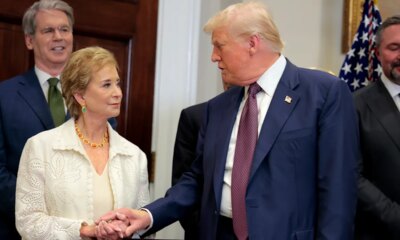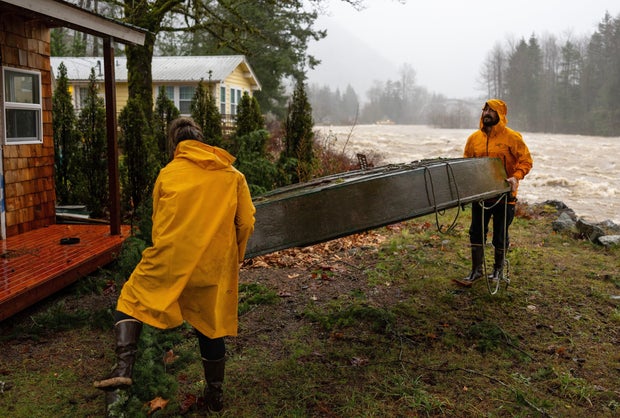News
Video: Trump and Harris Clash in a Fiery Presidential Debate

new video loaded: Trump and Harris Clash in a Fiery Presidential Debate
transcript
transcript
Trump and Harris Clash in a Fiery Presidential Debate
In their first face-to-face meeting, Kamala Harris put Donald Trump on the defensive as the former president tried to tie her to unpopular Biden administration policies.
-
“Kamala Harris. Let’s have a good debate.” “Nice to see you, have fun.” “Thank you.” “You will see during the course of his rallies, he talks about fictional characters like Hannibal Lecter. He will talk about windmills cause cancer. And what you will also notice is that people start leaving his rallies early out of exhaustion and boredom.” “Your running mate, JD Vance, has said that you would veto if it did come to your desk.” “Well, I didn’t discuss it with JD, in all fairness.” “She copied Biden’s plan. And it’s like four sentences — like, ‘Run, Spot, Run’ — four sentences that are just, ‘Oh, we’ll try and lower taxes.’ She doesn’t have a plan.” “We’re not going back. It’s time to turn the page. Let’s turn the page. Turn the page.”
Recent episodes in 2024 Elections

News
Video: Hiker Rescued From Quicksand in Arches National Park

new video loaded: Hiker Rescued From Quicksand in Arches National Park

By Rex Sakamoto
December 11, 2025
News
In a setback for Trump, Indiana lawmakers defeat redistricting plan

Members of the Indiana Senate debate the redistricting plan backed by President Trump in the state capitol Thursday.
Zach Bundy/WFYI
hide caption
toggle caption
Zach Bundy/WFYI
The Indiana Senate has voted 31 to 19 against the congressional redistricting called for by President Trump in his attempt to help Republicans win the 2026 midterm elections.
The defeat Thursday in the Indiana Senate, where 40 of the 50 members are Republicans, is the first time Trump’s redistricting campaign has been voted down by members of his own party. Republicans in Texas, Missouri and North Carolina have answered his call for an unusual mid-decade redistricting scramble.
“My opposition to mid-cycle gerrymandering is not in contrast to my conservative principles, my opposition is driven by them,” Republican state Sen. Spencer Deery said during the debate. “As long as I have breath, I will use my voice to resist a federal government that attempts to bully, direct and control this state or any state. Giving the federal government more power is not conservative.”
The move was also opposed by Indiana Democrats, who currently hold just two of the state’s nine U.S. House seats and said it would dilute the voting power of minority communities.
Usually, states redistrict early in the decade after the decennial census count.
The vote came after weeks of political turmoil and some threats
Trump has urged Republican-led states to conduct an unusual, mid-decade redistricting effort aimed at helping Republicans hold onto their majority in the U.S. House in next year’s midterm elections. California Democrats responded with their own redistricting effort but so far red states have gained a few-seat advantage over blue states.

The Indiana vote came after weeks of turmoil and with opposition from some Republicans, who had said their constituents did not want to alter the current districts.
Outside of the chamber ahead of the vote, protesters could be heard chanting “vote no” and “Hoosiers fight fair.”
Indiana Gov. Mike Braun, a Republican, has supported Trump’s call and both of them have threatened to support primary challenges against senators who don’t support redistricting. Amid rising tensions over redistricting in the state, Braun and other Republican lawmakers said they and their families have been the subject of anonymous threats.
As the Senate debated the bill to redistrict, Vice President Vance wrote on X that the Republican Senate President Pro Tempore Rodric Bray had told the administration he wouldn’t fight redistricting but was encouraging votes against it. “That level of dishonesty cannot be rewarded,” Vance wrote. Bray voted no.
Republicans who backed redistricting said it was for political gain to help keep the U.S. House in Republican control and noted that some Democratic-led states have redrawn their districts to favor Democrats in the past.
“Only a handful of districts throughout the United States will determine who controls Congress. We may or may not do our part today to keep our nation in the hands of Republicans and do the right thing for our state,” Republican state Sen. Mike Young told the chamber. “Whether we choose to play the game or not play the game we will determine the fate of our state and country.”
Ben Thorp is a reporter for WFYI. Larry Kaplow is with NPR.
News
Washington state braces for dangerous flooding as thousands could face evacuation orders

Residents began packing up and fleeing rising rivers in western Washington state Wednesday as a new wave of heavy rain swept into a region still reeling from a storm that triggered rescues and road closures a day earlier.
In the Pacific Northwest, an atmospheric river was swelling rivers toward record levels, with major flooding expected in some areas including the Skagit River, a major agricultural valley north of Seattle. In the town of Mount Vernon, officials ordered residents within the river’s floodplain to evacuate.
Earlier in the day, dozens of vehicles were backed up at a sandbag-filling station in the town as residents prepared for what Mayor Peter Donovan described as “what increasingly appears to be a worst-case scenario here.”
Washington Gov. Bob Ferguson declared a statewide emergency Wednesday, saying, “Lives will be at stake in the coming days.” He estimated that as many as 100,000 Washington residents may soon face evacuation orders.
“We expect rivers to hit historic levels as early as 4 a.m. tomorrow, lasting into Friday morning,” Ferguson wrote on social media.
Ferguson later posted that the National Oceanic and Atmospheric Association’s National Weather Prediction Service had predicted 18 major floods and 15 moderate floods in the state.
The National Weather Service warned of the possibility of “catastrophic flooding,” specifically along the Skagit and Snohomish rivers.
“Landslides are likely in areas of steep terrain within the considerable and catastrophic regions,” the weather service said.
Gent Welsh, adjutant general of the Washington National Guard, said hundreds of Guard members will be sent to help communities.
In the Mount Rainier foothills southeast of Seattle, Pierce County sheriff’s deputies rescued people at an RV park in Orting, including helping one man in a Santa hat wade through waist-deep water. Part of the town was ordered to evacuate over concerns about the Puyallup River’s extremely high levels and upstream levees.
A landslide blocked part of Interstate 90 east of Seattle, with photos from Eastside Fire & Rescue showing vehicles trapped by tree trunks, branches, mud and standing water, including a car rammed into the metal barrier on the side of the road.
Officials also closed a mountainous section of U.S. 2 due to rocks, trees and mud. The state transportation department said there were no detours available and no estimated time for reopening.
The Skagit River is expected to crest at roughly 47 feet in the mountain town of Concrete early Thursday, and roughly 41 feet in Mount Vernon early Friday.
Those are both “record-setting forecasts by several feet,” Skagit County officials said.
Flooding from the river long plagued Mount Vernon, the largest city in the county with some 35,000 residents. In decades past, residents would form sandbagging brigades when floods threatened, but businesses were often inundated. Flooding in 2003 displaced hundreds of people.
The city completed a floodwall in 2018 that helps protect the downtown. It passed a major test in 2021, when the river crested near record levels.
But the city is on high alert. The historic river levels expected Friday could top the wall, and some are worried that older levees could fail.
“The concern about that kind of pressure on the levy and dike system is real,” said Ellen Gamson, executive director of the Mount Vernon Downtown Association. “It could potentially be catastrophic.”
Gamson said many business owners were renting tables to place their inventory higher off the floor. Sheena Wilson, who owns a floral shop downtown, said she stacked sandbags by the doors and cleared items off the floor.
“If the water comes in above table height I’ve got bigger problems than my merchandise,” she said.
Jake Lambly, 45, added sandbags, tested water pumps and moved valuables to the top floor of the home he shares with his 19-year-old son. Lambly said he was concerned about damage in his neighborhood, where people “are just on the cusp of whether or not we can be homeowners.”
“This is my only asset,” he said from his front porch. “I got nothing else.”
Harrison Rademacher, a meteorologist with the weather service in Seattle, described the atmospheric river soaking the region as “a jet stream of moisture” stretching across the Pacific Ocean “with the nozzle pushing right along the coast of Oregon and Washington.”
Authorities in Washington have knocked on doors to warn residents of imminent flooding in certain neighborhoods, and evacuated a mobile home park along the Snohomish River. The city of Snohomish issued an emergency proclamation, while workers in Auburn, south of Seattle, installed temporary flood control barriers along the White River.
In Sumas, a small city along the U.S.-Canada border, a flood siren rang out at city hall and residents were told to leave. The border crossing was also closed to southbound commercial vehicles to leave more room for evacuations, according to the Abbotsford Police Department.
Climate change has been linked to some intense rainfall. Scientists say that without specific study they cannot directly link a single weather event to climate change, but in general it’s responsible for more intense and more frequent extreme storms, droughts, floods and wildfires.
Another storm system is expected to bring more rain starting Sunday, Rademacher said. “The pattern looks pretty unsettled going up to the holidays.”
-

 Alaska6 days ago
Alaska6 days agoHowling Mat-Su winds leave thousands without power
-

 Politics1 week ago
Politics1 week agoTrump rips Somali community as federal agents reportedly eye Minnesota enforcement sweep
-
Ohio1 week ago
Who do the Ohio State Buckeyes hire as the next offensive coordinator?
-

 Texas6 days ago
Texas6 days agoTexas Tech football vs BYU live updates, start time, TV channel for Big 12 title
-

 News1 week ago
News1 week agoTrump threatens strikes on any country he claims makes drugs for US
-

 World1 week ago
World1 week agoHonduras election council member accuses colleague of ‘intimidation’
-

 Washington3 days ago
Washington3 days agoLIVE UPDATES: Mudslide, road closures across Western Washington
-

 Iowa5 days ago
Iowa5 days agoMatt Campbell reportedly bringing longtime Iowa State staffer to Penn State as 1st hire
























